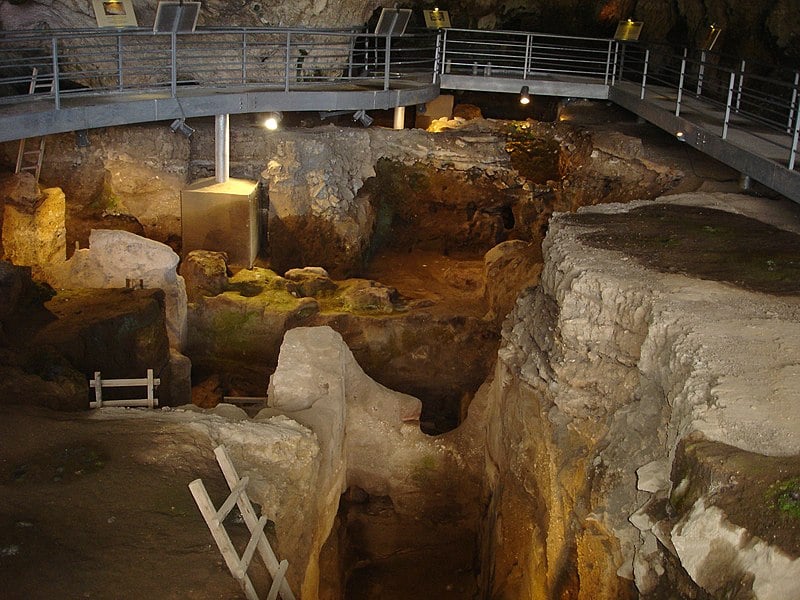
Theopetra Cave, located in the Meteora limestone rock formations of Thessaly, Central Greece, is likely to be the place of the oldest human construction on earth, as findings indicate that the cave was inhabited as early as 130,000 years ago.
According to archaeologists, evidence of human habitation in the cave can be traced without interruption from the Middle Palaeolithic to the end of the Neolithic period.
Dr. Aikaterini Kyparissi-Apostolika, head of the Ephorate of Palaeoanthroplogy and Speleaography of Greece’s Ministry of Culture and Sports, specializing in prehistoric archaeology and spelaeology, was the head of the team which began excavations in Theopetra Cave in 1987. Her team’s research at the cave continued through 2007.
Theopetra Cave may be oldest man made structure
Theopetra Cave is located at the foot of a 100-meter (330 foot) tall limestone cliff which looms over Theopetra village. The Lethaios River, a tributary of the Pineios River, flows nearby.
Geologists say that the limestone hill was formed between 137 and 65 million years ago, during the Upper Cretaceous geological period.
Archaeological evidence now indicates that humans occupied the cave during the Middle Palaeolithic period, approximately 130,000 years ago.
Theopetra cave has been described as being roughly quadrilateral in shape, with small niches on its periphery. It covers an area of about 500 square meters (5,380 square feet). The cave has a large entrance, which allows a good deal of light to enter into the interior.
Archaeologists have discovered a stone wall which once partially closed off the entrance of the cave.
Using a relatively new method of dating known as “Optically Stimulated Luminescence,” scientists have now been able to date this wall to around 23,000 years old.
The age of the wall has led researchers to assume that it had been built by the cave’s inhabitants to protect them from the cold. It has been claimed that this is the oldest known man-made structure in Greece, and possibly even in the world.
Additionally, by conducting micromorphological analysis on sedimentary samples collected from each archaeological layer, scientists discovered that there had been hot and cold spells during the cave’s occupation.
The cave’s population seemed to fluctuate over the years, relative to these changes in climate.
Further finds of the researchers were hominid footprints imprinted onto the cave’s soft earthen floor.
It has been speculated that these were made by several Neanderthal children, aged between two and four years old, who had lived in the cave during the Middle Palaeolithic period.
Overall research in Theopetra Cave has allowed archaeologists to gain a better understanding of the transition from the Palaeolithic to the Neolithic way of life in mainland Greece.
A recreation of “Avgi,” the 7,000-year-old teenage girl discovered in the cave
One of the most important finds inside Theopetra Cave was the remains of an 18-year-old woman who lived in Greece 7,000 years ago.
After years of intensive work, the teenager’s face was reconstructed by scientists and she was given the name of “Avgi” (Dawn).
Avgi is a woman who lived in Theopetra Cave during the Mesolithic era (7,000 BC), according to Athens University professor Manolis Papagrigorakis. Τhe professor has made it his mission to bring Greeks “face to face” with their ancestors.
An orthodontist, professor Papagrigorakis used Avgi’s teeth as a base for the total reconstruction of her face. Her clothes, and especially her hair, were very difficult to reproduce given the lack of substantial evidence.
Avgi, who was discovered by archaeologist Aikaterini Kyparissi-Apostolika, is displayed at the Acropolis Museum in Athens.